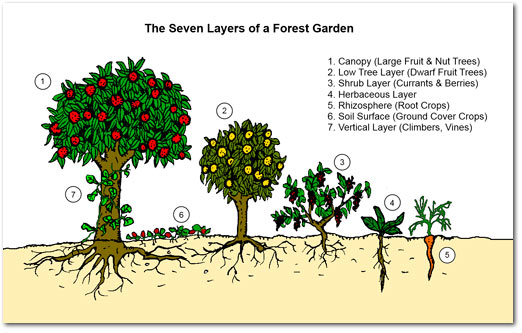How Nature grows plants
source: http://permaculturenews.org/2011/10/21/why-food-forests/
How Nature grows plants
We look at Nature’s system, and we copy them, so nature does our work for us, just like using earthworms to dig! That’s the spirit of Permaculture. No need for hard work…

Nature grows in a highly optimised pattern, utilising multiple layers and making the most of both horizontal and vertical space.
A food forest typically is comprised of seven layers, the uppermost layer being the canopy layer. The canopy layer is comprised of tall trees — typically large fruit and nut trees. Between the tall canopy layer trees, there is a layer of low growing, typically dwarf fruit trees. Mind you, a dwarf fruit tree can be up to 4m (12’) tall, so don’t think these are necessarily very low trees! Nestled between all the small trees are the shrubs – which are well represented by currants and berries. Filling the remaining space are the herbaceous layer, these are the culinary and medicinal herbs, companion plants, bee-forage plants and poultry forage plants. Any remaining space is occupied by ground cover plants. These form a living mulch that protects the soil, reduces water loss to evaporation, and prevents weeds growing. We can still go a level deeper to the rhizosphere, or root zone, the underground level which is occupied by all our root crops, such as potatoes, carrots, ginger, yacon, etc. While that might seem like a lot of plants in one space, we still have one more to fill, the upright vertical space. This is filled by climbers and vines, which can be run up trellises, arbours, fences, trees or any other vertical support. This category includes grapes, climbing beans, many berries, passionfruit, kiwi fruit, climbing peas, chokos and many other species that love to climb.
Now there are a lot of misconceptions about what a food forest actually is that I would like to clear up.
- Rows of trees are not food forests. They are instead what is described as an orchard.
- Rows of trees with some other plant underneath are not food forests, they are orchards with under-plantings.
- Rows of trees with rows of other plants alternating between them are not food forests, they are orchards employing intercropping.
A food forest my not necessarily have all seven layers, but it does have multiple layers, and even more importantly, it is a virtually self-sustaining living ecosystem.
In terms of form, the very thing that differentiates it from a two dimensional field of lettuce or any other monoculture is that it is a three dimensional structure.
In terms of function, being a living ecosystem gives it properties and attributes that are not present in agricultural systems and many gardens.
The benefits to be realised from food forests are as follows:
High Productivity
- High density planting ensures high yields.
- Biodiversity ensures continuous food supply throughout the year.
Natural Mulch, Compost & Fertilizer
- Just like a forest, food forests are self-mulching and cover the soil on their own to retain moisture.
- With such a high plant density, a high volume of fallen leaves accumulates and rots down to add organic matter to the soil.
- Decomposers, the class of insects that break down organic matter, such as earthworms, wood lice (pill bugs, slaters), and millipedes, work to help the natural composting process.
Natural Pest Control
- No chemicals required! Food forests use natural predators to get rid of pests – letting the experts do the work, naturally.
- Predatory insects have a permanent home (a natural ecosystem) and abundant food sources (nectar rich flowers) in a food forest. Provide these and they will come on their own! A regular veggie patch is a home only for pest insects, there’s nowhere for good bugs to live!
- An abundant, living ecosystem will attract birds and other larger predators, further contributing to natural pest control.
Resilience Through Biodiversity – Strength in Numbers
- Nature does not grow large areas of one plant species (or plants in neat rows either!), Nature prefers biodiversity, not monocultures! Mixing different types of plant together makes them grow better, period. It creates a natural synergy that benefits all the plants involved. The plants as a result are more resistant to pests and disease, and are more productive (and nicer to look at!).
- The use of Companion planting allow us to recreate nature’s biodiversity to gain these benefits
Easy Soil Repair – Chop n’ Drop
- In Nature, when plants die off, they stay in place. They’re not uprooted and binned! Don’t uproot annuals that have finished, cut the stem at soil level. The roots rot away to create thousands of intricate air and water channels in the soil. The tops of the chopped plants create a natural sheet compost system like the forest floor
- Preserve your soil, build paths. Don’t step in your garden beds, the soil is alive!!! (It’s actually a more complex ecosystem than anything that exists above ground). Stepping in your garden beds compacts the soil, closing all the air and water channels, making it harder for water and air to reach plant roots, which impairs the growth of plants.
Putting it all together…
A Food Forest is built to emulate a real forest — only we fill it with the food plants and trees that we want.
Real forests don’t need any work, they self-maintain — no pesticides, herbicides, weeding, crop rotation, mowing or digging. Food forests don’t need any of this either! Less work, more food, all natural! Why would you do anything else?
In conclusion, if we look beyond our modernised culture to Nature’s most advanced and life-abundant plant growing systems, it is clearly evident that working with Nature is the wisest and most productive path to sustainable food production.


Leave a Reply
Want to join the discussion?Feel free to contribute!